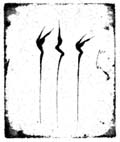3 Visual experiments«I’m not looking, I’m finding.» Picasso Some times I have found that a myriad of possibilities lay in a certain direction but because the time was short, have stopped at the experimental stage. These things one finds along the way are very exciting - they are the source for future projects. Here follows a brief summary of some of these experiments, all of which were done in the exploratory stage before the third semester started. 1 Silk screen with torn newspaper shablongsI tore figures in movement, flying through the air, rolling on the ground and dancing. As I printed layer upon layer, the forms reduced and I ended up with torso leaves. I pondered: Can it be possible to just go with this idea - some thing so simple as the torso of a leaf torn out of paper? My work was then subjected to Freudian analysis by a friend. I am apparently sex fixated. By this time I was feeling quite awful. My advisor said that as far as she could see, what I was doing had no relation to my theme. It seemed as though what I was addressing was the bodies’ ability to move. *The effects of discouragement on the mind of an artist* 2 Textile institute courseAt the beginning of the first semester, I had the privilege of auditing a silk screen course at the textile institute. This course was of much greater benefit to me than I had anticipated. It gave me an opportunity to reflect over the nature and meaning of repeat patterns and decorative art generally. I drew delicate pansies and juxtaposed them with sharp and dangerous thistles. These were printed on delicate silk chiffon. The contrast of the aggressive and rubbery black pigment against a blue gray silk chiffon back-ground pattern was really quite expressive. Learning how to go about experimentation in a more controlled scientific manner was very helpful. The neces-sity of taking into account the pH factor as well as the chemical properties of pigment and fiber was pointed out to me. Expertise pertaining to papermaking is available at the textile institute. It is possible to cross Mark-ensgt. and find chemicals that works just as well and are cheaper than sending to the USA and Japan. 3 The blanketsWhen I molded with the abaca fiber, I used a blanket underneath the sheet to soak us excess water. Sometimes I wonder if these blankets are not more interesting than the molded paper. 4 Paper-samplesLeaves were falling and I was feeling rather melancholy about a number of things. I went out and collected leaves and withered grass and fused them into paper. The brown birch leaves in particular gave quite interest-ing results. In this case, the mater-ials were very significant; leaves and bone glue. I could envisage making monumental sheets of the stuff. It was pointed out to me that this was the kind of minimalist solution one could have found in art from the 60’s. (Also, I thought, art conser-vators would hate it.) I then made human figures out of grass held together by bone glue. I thought of the late medieval dance of death. The person on the road met by death. It was only illustration I felt. It was too direct a solution. I treated leaves (nature) with plastic (culture). All kinds of samples were tried combining leaves with bone glue, cotton, linen, abaca fiber, and grass. There were other experiments with plastic flytex and Lamitex. 5 Metal plates as picturesWhile etching zinc, asphalt wore away in some places, and caused acid to eat right through to the back side of the plate. I wanted to find out if this could be done in a controlled way. Samples were etched in both copper and zinc. |
